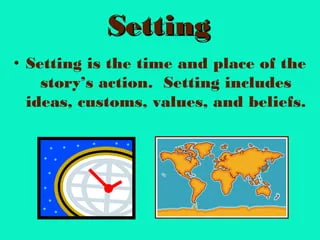The Setting: Where, When, and How it Shapes a Story
The setting in a story isn’t just a backdrop for the characters to cavort around in. It’s a living, breathing entity that shapes the plot, the characters, and the overall atmosphere of the narrative. It’s the time period, the geographical location, the social environment, and even the weather – all woven together to create a believable and immersive world for your readers to get lost in.
This article dives deep into the various aspects of setting in storytelling, exploring how it can be used to enrich your narratives and transport your readers to another time and place.
The Three Pillars of Setting
A strong setting is built on three key pillars:
-
Time Period: When does your story take place? Is it the bustling medieval era filled with knights and chivalry, the roaring twenties with its flappers and jazz music, or a distant future metropolis teeming with technological marvels? The time period you choose will influence everything from the characters’ clothing and speech patterns to the social norms and technological advancements that exist in their world.
-
Place: Where does your story unfold? Is it a quaint English village shrouded in fog, a sun-drenched island paradise, or a gritty cyberpunk cityscape? The location provides a physical space for your story to take place, influencing everything from the available resources to the potential dangers and conflicts your characters might face.
-
Social Environment: What is the social and cultural landscape of your story? Is it a war-torn nation under a tyrannical ruler, a utopian society with advanced social welfare programs, or a post-apocalyptic wasteland where survival is the only rule? The social environment shapes the characters’ values, beliefs, and behaviors, creating a context for their actions and decisions.
Setting Beyond the Backdrop
While these three pillars establish the foundation of your setting, a truly immersive setting goes beyond simply providing a location and time period. Here’s how setting can be used to elevate your story:
-
Creating Atmosphere: The setting can be used to establish a particular mood or feeling. A dark and stormy night on a deserted moor creates a sense of suspense and unease, while a bustling marketplace filled with vibrant colors and sounds evokes a sense of excitement and possibility.
-
Driving the Plot: The setting can be a character itself, throwing obstacles in the characters’ paths and shaping their choices. A harsh winter storm might force your characters to seek shelter in a dangerous location, or a dense jungle might make navigation a constant challenge.
-
Character Development: The setting can influence the way characters develop and behave. A character raised in a war-torn environment will likely be more cautious and distrustful than someone raised in a peaceful society. The social norms and expectations of the setting will also play a role in shaping the characters’ personalities and motivations.
Examples of Setting in Action
To illustrate the power of setting, let’s look at a few classic examples:
-
The fog-shrouded streets of Charles Dickens’ London in Oliver Twist create a sense of mystery and danger, reflecting the harsh realities of poverty and crime in 19th-century England.
-
The desolate Martian landscape in Ray Bradbury’s Fahrenheit 451 heightens the sense of isolation and oppression, emphasizing the dystopian themes of censorship and control.
-
The sprawling metropolis of Coruscant in the Star Wars universe showcases a vast and diverse society filled with different cultures and technologies, creating a sense of wonder and possibility.
Crafting Your Own World
When building your setting, consider the following tips:
-
Conduct research: If your story is set in a specific historical period or location, delve into research to ensure your portrayal is accurate and believable.
-
Engage the senses: Don’t just tell readers about the setting, show it to them. Use vivid descriptions that appeal to the five senses to bring your world to life.
-
Consider the impact: How will the setting affect your characters and their choices? How will it influence the plot and the overall tone of your story?
FAQ: Setting in Storytelling
Q: How much detail should I include about the setting?
A: While you want to provide enough detail to immerse your readers, avoid info-dumping. Focus on the details that are most relevant to the story and that will create a strong atmosphere.
Q: Can I have multiple settings in my story?
A: Absolutely! Epic fantasy novels often take place across vast continents, while a mystery novel might shift between the crime scene, the detective’s office, and the suspect’s home.






More Stories
Is there a lifetime limit on epidural steroid injection?
What is Section 20 of the Motor Accident Insurance Act (Queensland)?
Where to Watch USMNT vs Jamaica National Football Team